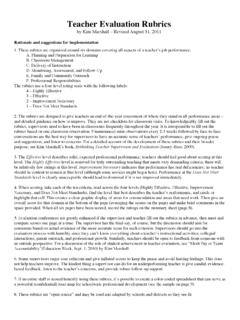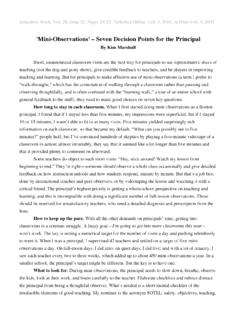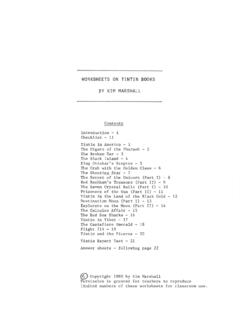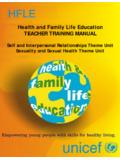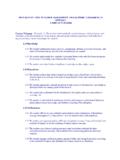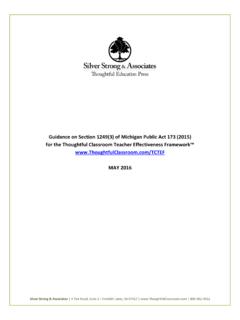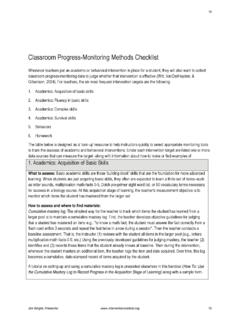Transcription of Teacher Evaluation Rubrics - Marshall Memo
1 Teacher Evaluation Rubrics by Kim Marshall Revised September 4, 2010 Rationale and suggestions for implementation 1. These Rubrics are organized around six domains covering all aspects of a Teacher s job performance: A. Planning and Preparation for Learning B. Classroom Management C. Delivery of Instruction D. Monitoring, Assessment, and Follow-Up E. Family and Community Outreach F. Professional Responsibilities The Rubrics use a four-level rating scale with the following labels: 4 Highly Effective 3 Effective 2 Improvement Necessary 1 Does Not Meet Standards 2. The Rubrics are designed to give teachers an end-of-the-year assessment of where they stand in all performance areas and detailed guidance on how to improve. They are not checklists for classroom visits. To knowledgeably fill out the Rubrics , principals need to have been in classrooms frequently throughout the year; it is irresponsible to fill out the Rubrics based on one classroom observation. Unannounced mini-observations every 2-3 week followed by face-to-face conversations are the best way for principals to have an accurate sense of teachers performance, give ongoing praise and suggestions, and listen to push-back.
2 For a detailed account of the development of these Rubrics and the rationale for not including student results see Kim s recent book, Rethinking Teacher Supervision and Evaluation (Jossey-Bass, 2009). 3. The Effective level describes solid, expected professional performance; teachers should feel good about scoring at this level. The Highly Effective level is reserved for truly outstanding teaching that meets very demanding criteria; there will be relatively few ratings at this level. Improvement Necessary indicates that performance has real deficiencies; it is not a gentleman s C and nobody should be content to remain at this level. Performance at the Does Not Meet Standards level is clearly unacceptable and needs to be improved immediately. 4. When scoring, take each of the ten criteria, read across the four levels (Highly Effective, Effective, Improvement Necessary, and Does Not Meet Standards), find the level that best describes the Teacher s performance, and circle or highlight that cell.
3 This creates a clear graphic display of areas for commendation and areas that need work. Then give an overall score for that domain at the bottom of the page (averaging the scores on the page) and make brief comments in the space provided. When all six pages have been scored, record the ratings on the summary sheet (page 8). 5. Evaluation conferences are greatly enhanced if the principal and Teacher fill out the Rubrics in advance, then meet and compare scores one page at a time. The principal has the final say, of course, but the discussion should aim for consensus based on actual evidence of the more accurate score for each criterion. Principals should go into the Evaluation process with some humility since they can t possibly know everything about a Teacher s instructional activities, collegial interactions, parent outreach, and professional growth. Similarly, teachers should be open to feedback from someone with an outside perspective who has been in their classroom numerous times.
4 6. Some principals sugar-coat criticism and give inflated scores so as not to hurt feelings. This does not help teachers improve. The kindest thing a principal can do for an underperforming Teacher is give candid, evidence-based feedback, listen to the Teacher s concerns, and provide robust follow-up support. 7. If an entire staff is scored honestly using these Rubrics , it s possible to create a color-coded spreadsheet that can serve as a powerful (confidential) road-map for schoolwide professional development (see the sample on page 9). 8. These Rubrics are open source and may be used and adapted by schools and districts as they see fit. A. Planning and Preparation for LearningThe Teacher :4 Highly Effective3 Effective2 Improvement Necessary1 Does Not Meet Standardsa. KnowledgeIs expert in the subject area and has a cutting-edge grasp of child development and how students learn. Knows the subject matter well and has a good grasp of child development and how students somewhat familiar with the subject and has a few ideas of ways students develop and little familiarity with the subject matter and few ideas on how to teach it and how students a well-honed game plan for the year that is tightly aligned with state standards and the year so students will meet state standards and be ready for external done some thinking about how to cover high standards and test requirements this lesson by lesson and has little familiarity with state standards and most units backwards, with well-thought-out big ideas, essential questions, knowledge, and skill some units backwards with big ideas, essential questions, knowledge, and skill lessons with some thought to larger goals and objectives and higher-order thinking on an ad hoc basis with little or no consideration for long-range curriculum diagnostic, on-the-spot, interim.
5 And summative assessments to monitor student on-the-spot and unit assessments to measure student unit tests as instruction final tests shortly before they are students' misconceptions and confusions and develops multiple strategies to overcome misconceptions that students might have and plans to address a hunch about one or two ways that students might become confused with the without considering misconceptions that students might have about the each lesson with clear, measurable goals closely aligned with standards and unit lessons focused on measurable outcomes aligned with unit lessons with some consideration of long-term lessons aimed primarily at entertaining students or covering textbook highly relevant lessons that will motivate all students and sweep them up in active lessons that are relevant, motivating, and likely to engage students in active lessons that will catch some students interest and perhaps get a discussion lessons with very little likelihood of motivating or involving lessons involving an appropriate mix of top-notch, multicultural learning lessons that use an effective, multicultural mix of lessons that involve a mixture of good and mediocre learning lessons that rely mainly on mediocre and low-quality textbooks, workbooks, or lessons that break down complex tasks and address all learning needs, styles, and lessons that target several learning needs, styles, and lessons with some thought as to how to accommodate special needs lessons with no Artfully uses room arrangement, materials, and displays to maximize student learning of all classroom furniture, materials, and displays to support unit and lesson goals.
6 Organizes furniture and materials to support the lesson, with only a few decorative a conventional furniture arrangement, hard-to-access materials, and few wall rating:____ Comments: B. Classroom ManagementThe Teacher :4 Highly Effective3 Effective2 Improvement Necessary1 Does Not Meet direct, specific, consistent, and tenacious in communicating and enforcing very high communicates and consistently enforces high standards for student behavior. Announces and posts classroom rules and up with ad hoc rules and punishments as events unfold during the RelationshipsShows warmth, caring, respect, and fairness for all students and builds strong fair and respectful toward students and builds positive fair and respectful toward most students and builds positive relationships with sometimes unfair and disrespectful to the class; plays RespectWins all students respect and creates a climate in which disruption of learning is respect and refuses to tolerate the respect of some students but there are regular disruptions in the not respected by students and the classroom is frequently chaotic and sometimes Implements a program that successfully develops positive interactions and social-emotional positive interactions among students and teaches useful social lectures students on the need for good behavior, and makes an example of bad berates bad students, blaming them for their poor RoutinesSuccessfully inculcates class routines up front so that students maintain them throughout the routines and has students maintain them all to train students in class routines but many of the routines are not not teach routines and is constantly nagging, threatening, and punishing develops students self-discipline, self-efficacy.
7 And sense of students self-discipline and teaches them to take responsibility for their own to get students to be responsible for their actions, but many lack unsuccessful in fostering self-discipline in students; they are dependent on the Teacher to a highly effective discipline repertoire and can capture and hold students attention any time. Has a repertoire of discipline moves and can capture and maintain students a limited disciplinary repertoire and students are frequently not paying attention. Has few discipline moves and constantly struggles to get students coherence, lesson momentum, and silky-smooth transitions to get the most out of every academic learning time through coherence, lesson momentum, and smooth loses teaching time due to lack of clarity, interruptions, and inefficient a great deal of instructional time because of confusion, interruptions, and ragged alert, poised, dynamic, and self-assured and nips virtually all discipline problems in the a confident, dynamic presence and nips most discipline problems in the to prevent discipline problems but sometimes little things escalate into big unsuccessful at spotting and preventing discipline problems, and they frequently students to buy into a highly effective system of incentives linked to intrinsic rewards.
8 Uses incentives wisely to encourage and reinforce student cooperation. Uses extrinsic rewards in an attempt to get students to cooperate and away goodies ( , free time) without using it as a lever to improve behavior. Overall rating:____ Comments: C. Delivery of InstructionThe Teacher :4 Highly Effective3 Effective2 Improvement Necessary1 Does Not Meet high expectations and determination and convinces all students that they will master the to students: This is important, you can do it, and I m not going to give up on students that the subject matter is important and they need to work up on some students as inculcates a "growth" mindset: take risks, learn from mistakes, through effective effort you can and will achieve at high students that effective effort, not innate ability, is the 't counteract students' misconceptinos about innate a "fixed" mindset about ability: some students have it, some don' students exactly what s expected by posting essential questions, goals, Rubrics , and exemplars of proficient students a clear sense of purpose by posting the unit s essential questions and the lesson s students the main learning objectives of each lessons without giving students a sense of where instruction is grabs students interest and makes connections to prior knowledge, experience, and students prior knowledge and hooks their interest in each unit and only sometimes successful in making the subject interesting and relating it to things students already hooks students interest or makes connections to their presents material clearly and explicitly, with well-chosen examples and vivid and appropriate clear explanations, appropriate language, and good examples to present uses language and explanations that are fuzzy, confusing, or presents material in a confusing way.
9 Using language that is highly effective strategies, materials, and groupings to involve and motivate effective strategies, materials, and classroom groupings to foster student a limited range of classroom strategies, materials, and groupings with mixed only one or two teaching strategies and types of materials and fails to reach most all students highly involved in focused work in which they are active learners and students actively think about, discuss, and use the ideas and skills being to get students actively involved but some students are lectures to passive students or has them plod through textbooks and reaches all students by skillfully differentiating and and scaffolds instruction to accommodate most students learning to accommodate students with learning deficits, but with mixed to differentiate instruction for students with learning adapts lessons and units to exploit teachable moments and correct flexible about modifying lessons to take advantage of teachable doesn't take advantage of teachable rigid and inflexible with lesson plans and rarely takes advantage of teachable has students summarize and internalize what they learn and apply it to real-life students sum up what they have learned and apply it in a different context.
10 Sometimes brings closure to lessons and asks students to think about on at the end of each lesson without closure or rating:____ Comments: D. Monitoring, Assessment, and Follow-UpThe Teacher :4 Highly Effective3 Effective2 Improvement Necessary1 Does Not Meet Standardsa. CriteriaPosts and reviews the criteria for proficient work, including Rubrics and exemplars, and students internalize clear criteria for proficiency, including Rubrics and exemplars of student students some of the qualities that their finished work should students to know (or figure out) what it takes to get good students a well-constructed diagnostic assessment up front, and uses the information to fine-tune students knowledge and skills up front and makes small adjustments based on the a quick K-W-L (Know, Want to Know, Learned) exercise before beginning a instruction without diagnosing students' skills and a variety of effective methods to check for understanding; immediately unscrambles confusion and checks for understanding and gives students helpful information if they seem mediocre methods ( , thumbs up, thumbs down) to check for understanding during ineffective methods ("Is everyone with me?)
